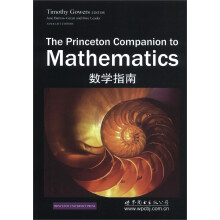Pre face
Contributors
Part Ⅰ Introduction
Ⅰ.1 What Is Mathematics About?
Ⅰ.2 The Language and Grammar of Mathematics
Ⅰ.3 Some Fundamental Mathematical Definitions
Ⅰ.4 The General Goals of Mathematical Research
Part Ⅱ The Origins of Modern Mathematics
Ⅱ.1 From Numbers to Number Systems
Ⅱ.2 Geometry
Ⅱ.3 The Development of Abstract Algebra
Ⅱ.4 Algorithms
Ⅱ.5 The Development of Rigor in Mathematical Analysis
Ⅱ.6 The Development of the Idea of Proof
Ⅱ.7 The Crisis in the Foundations of Mathematics
Part Ⅲ Mathematical Concepts
Ⅲ.1 The Axiom of Choice
Ⅲ.2 The Axiom of Determinacy
Ⅲ.3 Bayesian Analysis
Ⅲ.4 Braid Groups
Ⅲ.5 Buildings
Ⅲ.6 Calabi-Yau Manifolds
Ⅲ.7 Cardinals
Ⅲ.8 Categories
Ⅲ.9 Compactness and Compactification
Ⅲ.10 ComputationaI Complexity Classes
Ⅲ.11 Countable and Uncountable Sets
Ⅲ.12 C*.Algebras
Ⅲ.13 Curvature
Ⅲ.14 Designs
Ⅲ.15 Determinants
Ⅲ.16 Differential Forms and lntegration
Ⅲ.17 Dimension
Ⅲ.18 Distributions
Ⅲ.19 Duality
Ⅲ.20 Dynamical Systems and Chaos
Ⅲ.21 Elliptic Curves
Ⅲ.22 The Euclidean Algorithm and Continued Fractions
Ⅲ.23 The Euler and Navier-Stokes Equations
Ⅲ.24 Expanders
Ⅲ.25 The Exponential and Logarithmic Functions
Ⅲ.26 The Fast Fourier Transform
Ⅲ.27 The Fourier Transform
Ⅲ.28 Fuchsian Groups
Ⅲ.29 Function Spaces
Ⅲ.30 Galois Groups
Ⅲ.31 The Gamma Function
Ⅲ.32 Generating Functions
Ⅲ.33 Genus
Ⅲ.34 Graphs
Ⅲ.35 Hamiltonians
Ⅲ.36 The Heat Equation
Ⅲ.37 Hilbert Spaces
Ⅲ.38 Homology and Cohomology
Ⅲ.39 Homotopy Groups
Ⅲ.40 The Ideal Class Group
Ⅲ.41 Irrational and Transcendental Numbers
Ⅲ.42 The Ising Model
Ⅲ.43 Jordan NormaI Form
Ⅲ.44 Knot Polynomials
Ⅲ.45 K-Theory
Ⅲ.46 The Leech lattice
Ⅲ.47 L-Functions
Ⅲ.48 Lie Theory
Ⅲ.49 Linear and Nonlinear Waves and Solitons
Ⅲ.50 Linear Operators and Their Properties
Ⅲ.51 Local and Global in Number Theory
Ⅲ.52 The Mandelbrot Set
Ⅲ.53 Manifolds
Ⅲ.54 Matroids
Ⅲ.55 Measures
……
PartⅤ Theorems and Problems
PartⅥ Mathematicians
PartⅦ The Influence of Mathematics
PartⅧ Final Perspectives
Index

